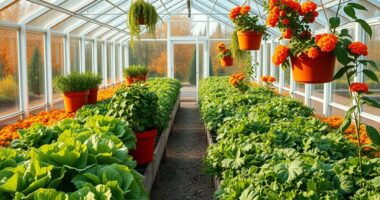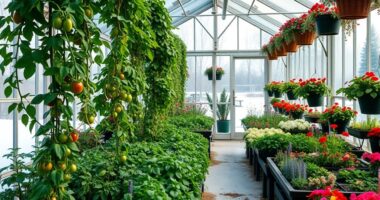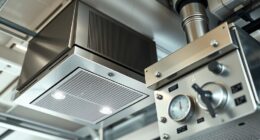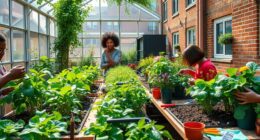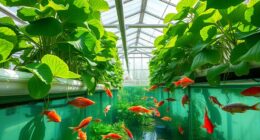To get your greenhouse ready for the spring growing season, start by cleaning it thoroughly. Remove any debris and equipment, then wash the glass panes for maximum sunlight. Make sure ventilation openings work properly to keep air flowing. Consider efficient heating solutions and ensure you have adequate lighting. Lastly, implement effective watering systems to manage moisture levels. If you want more tips on selecting the right plants and organizing your space, there's plenty more to explore!
Key Takeaways
- Clean the greenhouse thoroughly, removing debris and equipment, to create a healthy environment for plants and prevent pest infestations.
- Ensure proper ventilation by checking roof and side vents, and using automatic louvre vents for optimal airflow.
- Set up efficient heating and cooling solutions, like high-efficiency heaters and portable AC units, to maintain ideal growing temperatures.
- Maximize lighting by cleaning panels, using energy-efficient grow lights, and painting interior surfaces to reflect more light onto plants.
- Implement an automated irrigation system to monitor moisture levels and support precise water management for your crops.
Greenhouse Cleaning and Organization
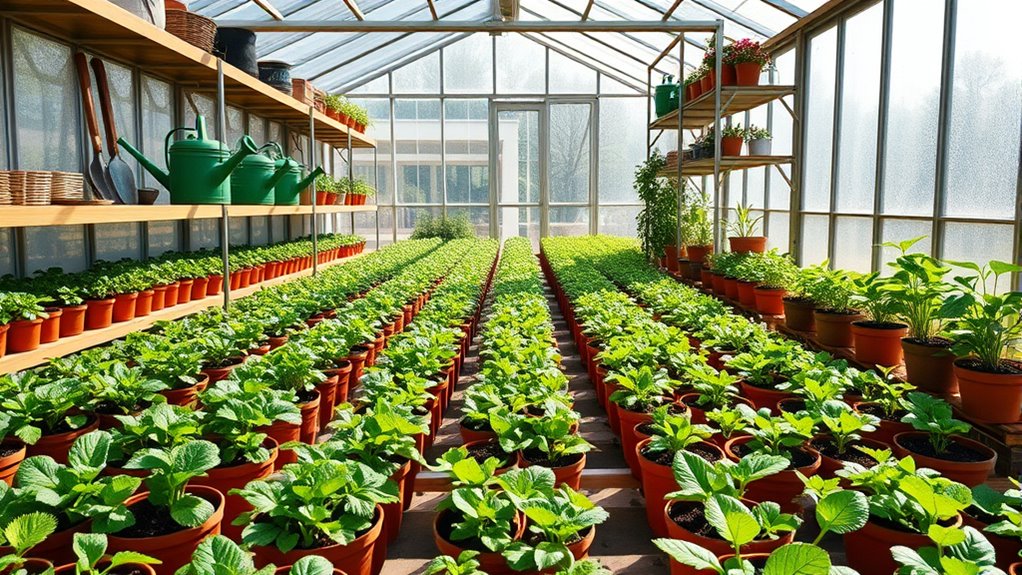
When you set up your greenhouse for spring, cleaning and organizing it should be your top priority. Start by removing all equipment and debris, using long-handled brushes for hard-to-reach areas. Clean glass panes inside and out with warm water and a soft cloth, avoiding abrasive materials that can scratch. For the framework, brush down surfaces and check gutters for blockages to ensure proper drainage.
As you clean, inspect for broken panes or equipment that need replacement, and oil vent joints to ensure smooth operation. After cleaning, return only essential items to keep your space organized. Regular maintenance prevents pests and diseases from overwintering, maximizing light levels and promoting a healthy growing environment.
Ensuring Proper Ventilation

Proper ventilation is crucial for maintaining a healthy greenhouse environment, as it regulates temperature and humidity levels essential for plant growth. You should ensure that your greenhouse has a combination of roof and side vents to facilitate effective air circulation. Automatic louvre vents can make this process easier by adjusting airflow based on temperature changes. Additionally, through ventilation is important as it prevents pockets of stagnant air, ensuring uniform distribution of temperature and humidity. Consider using circulating fans to prevent hot spots and promote uniform growth. Regularly inspect your vents and fans for blockages and ensure they're functioning properly. Monitor temperature and humidity levels with digital tools, and adjust your ventilation strategy according to seasonal changes.
Effective Heating and Cooling Solutions

Maintaining a comfortable temperature in your greenhouse is just as important as ensuring proper ventilation. For heating, consider high-efficiency unit heaters to provide steady warmth while cutting energy costs. Gas heaters can work well but require monitoring for fume buildup. Proper maintenance is essential to prevent increased strain on your heating systems and ensure they operate efficiently throughout the growing season. Using a portable AC unit can further enhance your greenhouse's climate control by providing additional cooling during peak summer months. Additionally, regular maintenance of your heating systems can help avoid operational issues, similar to the maintenance practices for airless paint sprayers. You might also explore solar energy to power electric heaters, reducing your reliance on traditional sources. For cooling, shade cloths are great for blocking direct sunlight, while ventilation systems are crucial for airflow. Implementing geothermal heat pumps can significantly enhance your heating and cooling efficiency, making them an effective choice for maintaining optimal greenhouse temperatures.
In dry climates, evaporative cooling can help, and misting systems effectively lower temperatures. Lastly, proper insulation keeps your greenhouse stable by retaining cool air in hot weather and warm air during colder nights.
Implement these solutions to create an ideal growing environment.
Maximizing Lighting and Shading

To maximize lighting and shading in your greenhouse, you'll want to focus on both natural and artificial light sources.
Start by cleaning your greenhouse panels regularly to enhance sunlight exposure. Consider painting the interior surfaces with gloss white to reflect more light. Use shade cloths to manage excessive sunlight and prevent overheating during peak hours.
When arranging plants, space them out to ensure each receives adequate light. For artificial lighting, LED grow lights are energy-efficient and customizable for different growth stages. Full-spectrum fluorescent bulbs are popular for germinating seedlings and can be particularly effective when positioned close to the plants.
Strategically place these lights to mimic natural cycles and adjust timings as needed. Additionally, using reflective materials can improve light distribution and efficiency, making your greenhouse a thriving environment for your plants.
Efficient Water Management Practices

While efficient water management practices are essential for a successful greenhouse, implementing the right systems can significantly enhance plant health and growth.
Consider using drip irrigation for precise water control, minimizing evaporation and runoff. For larger spaces, overhead sprinklers may work, but they're less efficient. Additionally, ensuring ventilation windows are functional helps maintain humidity levels, further benefiting plant health. Utilizing optimal conditions such as consistent moisture and full sun exposure can also support vigorous plant growth.
Drip irrigation offers precise water control, reducing evaporation and runoff, while overhead sprinklers are less efficient for larger areas.
Explore ebb and flow systems for specific crops and fogging systems to boost humidity for tropical plants. Incorporate water recycling with closed hydroponic systems to reduce waste and keep your plants thriving.
Regular water testing and quality management, including pH monitoring, ensure optimal conditions.
Lastly, integrating automated irrigation systems can help you monitor moisture levels in real-time, allowing for precise adjustments that enhance both plant health and sustainability.
Selecting and Sowing the Right Plants

Selecting the right plants for your spring greenhouse can set the stage for a bountiful growing season. Focus on cool-weather crops like broccoli, spinach, and peas, which thrive in early spring. You'll also want to include hardy annuals such as snapdragons and pansies to add color. Don't forget frost-tolerant herbs like cilantro and parsley, along with early fruits like strawberries. Additionally, consider starting seeds for exotic plants like Meyer lemons and Finger Limes, which can also be propagated during this time.
Start sowing seeds 2-8 weeks before the last frost date, maintaining temperatures between 21-27°C (70-80°F) for optimal germination. Ensure seedlings get plenty of moisture and sunlight while monitoring ventilation to prevent diseases. Consider succession planting for continuous harvests and rotate crops to keep your soil healthy. Happy planting!
Frequently Asked Questions
How Do I Prevent Pests From Entering the Greenhouse?
To prevent pests from entering your greenhouse, start by installing insect screens on all intake points.
Regularly clean and inspect these screens for damage to ensure they're effective.
Consider using air-lock entrances to minimize pest entry when doors open.
Maintain vegetation-free zones around the greenhouse and remove weeds regularly to reduce hiding spots.
Lastly, monitor for pests early with sticky traps and take action quickly if you spot any infestations.
What Tools Are Essential for Greenhouse Maintenance?
For effective greenhouse maintenance, you'll need several essential tools.
Start with trowels and hand forks for transplanting and handling plants. Pruning shears will help you trim and shape your greenery, while gloves protect your hands.
Don't forget markers and labels to track your plants. Long-handled tools like hoes, rakes, and shovels make it easier to manage your space.
Lastly, invest in watering tools and monitoring devices to ensure optimal growing conditions.
How Often Should I Inspect My Greenhouse Equipment?
You should inspect your greenhouse equipment regularly to ensure everything functions properly. Aim for monthly checks, focusing on critical components like ventilation and heating systems.
During these inspections, look for signs of wear, rust, or damage, and address any issues immediately.
Also, consider seasonal inspections before major temperature changes, as this prepares your greenhouse for the demands of varying weather conditions.
Regular maintenance keeps your equipment efficient and your plants healthy.
Can I Use Recycled Materials for Greenhouse Construction?
Absolutely, you can use recycled materials for greenhouse construction!
It's a cost-effective and eco-friendly option that helps reduce waste while allowing for creativity in design. Materials like old wood, PVC, and plastic containers can be repurposed effectively.
Just make sure to treat them properly for durability. Not only will you save money, but you'll also contribute to sustainable gardening practices, making your greenhouse a unique and responsible addition to your gardening efforts.
What Are the Best Practices for Greenhouse Waste Disposal?
Did you know that composting can reduce landfill waste by up to 30%?
For effective greenhouse waste disposal, prioritize proper pile management by keeping it well-aerated and regularly turning it.
Control moisture to prevent unpleasant odors and anaerobic conditions.
Be mindful of wind when handling compost to minimize odor dispersal.
Engaging your community in sustainable practices can also enhance awareness and collaboration, making your waste disposal efforts more impactful and beneficial for everyone.
Conclusion
As you step into spring, your greenhouse is more than just a staging area; it's a canvas for your gardening dreams. By tidying up, ensuring fresh air flows, and embracing the warmth of the sun, you're not just prepping for a season—you're nurturing life. With careful planning and the right choices, you're inviting a bountiful harvest. So roll up your sleeves, and let the magic of growth start to unfold in your little sanctuary of green.


